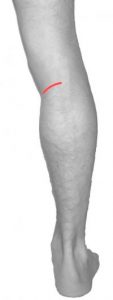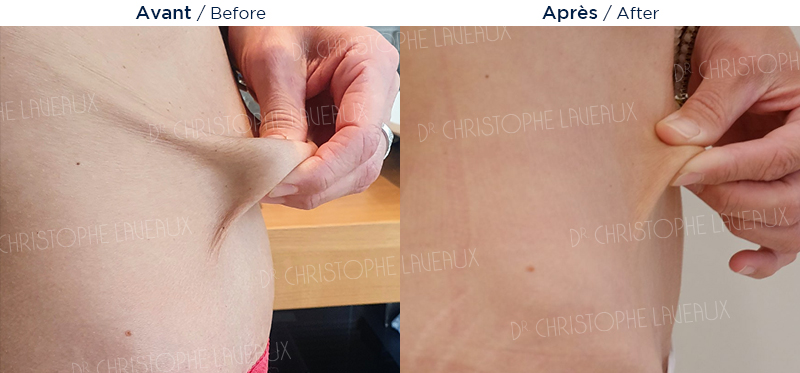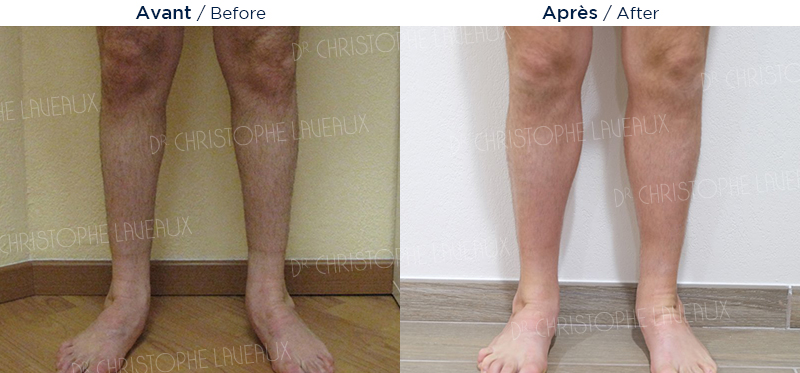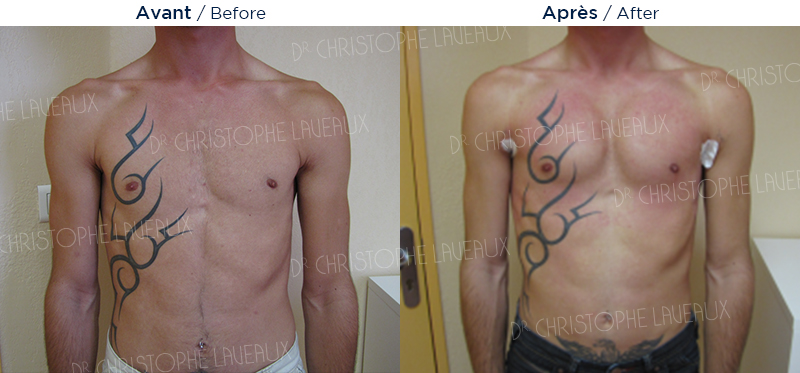Other body surgeries
• J-Plasma Renuvion® • Calves implants • Quadriceps implants • Biceps & Triceps implants • Deltoid implants • Abdominal muscle implants • Pectoral implants •
J-Plasma Renuvion®
Renuvion® (or J-Plasma) treatment is a minimally invasive, surgical procedure used to firm and tighten the skin by working on the internal dermis and collagen fibres.
Renuvion® can be performed as a stand-alone procedure or in addition to other techniques, such as liposuction.
Using a combination of helium-plasma and radiofrequency energy, Renuvion® rapidly heats tissues causing collagen and other fibres to contract. In a split second, the skin cools again after having reached the ideal contraction temperature.
The device is introduced under the skin through small openings of less than one centimetre, comparable to those used to perform liposuction. Anaesthesia is local or general depending on the case.
Although the tightening effect of this scar free lift is immediate, further improvement still is visible for 6 to 9 months due to treatment-induced neo-collagenesis.
Loose skin can be improved especially in the arms, thighs, knees, belly, hips, back, face and neck.
In case of significant excess skin (abdominal apron, extreme sagging skin on the limbs and neck etc …), scar lifting techniques remain the preferred option.
Renuvion® really holds its place:
- As a stand-alone treatment for moderate excess skin, thus avoiding a facelift with scarring
- in addition to liposuction to enable tightening for the skin
- to supplement or maintain the result of a previous surgical facelift
- to treat areas areas which are inaccessible to conventional surgical techniques such as the forearms.
The after effects are comparable to those of liposuction. Swelling, bruising and some pain is experienced for several days (1 to 3 weeks depending on the case). Wearing a compression garment for a period of 1 month is recommended.
Renuvion® is approved by the FDA and is a major technological innovation in cosmetic surgery. Its beneficial effects and safety have been acclaimed by numerous scientific articles.
Calf augmentation
The correction of hypoplastic calves (undersized calves) can occur in the context of either restorative surgery (congenital muscular atrophy, after effects of polio) or cosmetic surgery.
This is a preferredis preferred choice for increasing calf size.
This is the only technique available for patients who do not have sufficient fat reserves to have lipomodelage and who also want a lasting result with one operation.
The implant is most often placed in an internal position. More rarely, an external implant is recommended. Two calf implants can be placed on the same calf at the same time when the increase in calf size is more general, usually in the context of a reconstruction (after effects of polio or clubfoot).
The implants used are specially designed for calf augmentations. They are pre-filled with a highly cohesive silicone gel (very strong) and have a durable casing. In the absence of violent trauma (traffic accident…) the risk of rupture is very low. If a rupture occurs, the implant should be changed, but this is not an emergency. Two main types of implants are available (arched type Glicenstein or cone-type Montellano).
The shape and volume of the implant are tailored to meet the needs of each patient.

The incision is hidden in a fold of the knee bend and is between 3 and 5 cm in length.
The implant is positioned deep against the calf muscles.
The procedure is performed under local or general anaesthesia and takes about 1 hour. The patient lies on their stomach. No drain is inserted.
Hospitalisation is 24 hours.
Pain, which is relieved by the appropriate analgesics, only lasts for the first few days but discomfort may be felt for several weeks.
Showering is permitted from the day after the procedure.
Complete healing is achieved in 2 to 3 weeks.
Sporting activities may be resumed 3 months after the treatment.
As with any surgery, a number of complications can occur. But the likelihood of these complications is reduced in the hands of a qualified plastic surgeon and in the presence of a competent anaesthetist.
The patient’s compliance to instructions given by the surgeon is also essential and include:
- stopping smoking 1 month before and after the procedure (reduction of all risks) ;
- not taking aspirin for 10 days before and after the procedure (reduced risk of hematoma) ;
- stopping the pill two months before and after the procedure (reducing the risk of phlebitis and pulmonary embolism).
Rare complications that could occur include, but are not limited to risk of hematoma, infection, scarring and thrombo-embolic complications (phlebitis).
In the event of a complication, appropriate measures will be taken.
As this procedure is considered purely for aesthetic purposes, no coverage is provided by health insurance.
In some rare cases (polio) a partial reimbursement of the cost of the procedure may be considered upon prior agreement.
In case of prior agreement, you will be responsible for the additional surgeon and anesthesiologist fees which will be redeemable in whole or in part by your health insurance.
Quadriceps implants
Silicone implants are inserted to increase thigh volume resulting in a more athletic appearance.
Thigh implants
The main implant is positioned at the anterior part of the thigh next to the quadriceps muscle. Other smaller implants in the lower thigh near the knee, or in the inner thighs can be added to complete the overall appearance.
The tailor made implants used are made of soft silicone.
A main incision of 4-6 cm is made at the top of each thigh.
If small complementary implants near the knees or inside the thighs are placed, small complementary scars are visible.
The implant is placed deeply on the surface of the muscles but under the muscular aponeurosis.
The procedure takes place under general anaesthesia and lasts an average of 90 minutes. No drain is put in place.
Hospitalisation is 24 hours.
Pain, which is relieved by the appropriate analgesics, only lasts for the first few days but discomfort may be felt for several weeks.
Showering is permitted from the day following the procedure.
LHealing is achieved within 2 to 3 weeks.
Walking is possible immediately after surgery while moderate sporting activities may be resumed after 2 weeks. Intensive sports activity involving the lower limbs are possible from 6 weeks after the procedure.
A compression garment should be worn under clothes 24 hours a day for a period of 1 month.
As with any surgery, a number of complications can occur. But the likelihood of these complications is reduced in the hands of a qualified plastic surgeon and in the presence of a competent anaesthetist.
The patient’s compliance to instructions given by the surgeon is also essential and include:
- stopping smoking 1 month before and after the procedure (reduction of all risks) ;
- not taking aspirin for 10 days before and after the procedure (reduced risk of hematoma) ;
- taking anticoagulant medication to prevent the risk of phlebitis for 10 days after the procedure.
Rare complications that could occur include, but are not limited to risk of hematoma, serome, infection, scarring and thrombo-embolic complications (phlebitis).
In the event of a complication, appropriate measures will be taken.
Biceps and triceps implants
The volume of the arm muscles, biceps and triceps, can be increased with silicone implants.
Both the biceps and triceps can be increased, in which case 2 separate interventions are required.
Biceps and triceps implants
The implants are positioned either under the muscle fascia on the surface of the muscle or intramuscularly.
The tailor made implants are made of soft silicone.
The main incision of 3-5 cm is made in the hollow of the armpit.
The implant is placed deeply on the surface of the muscles but under the muscular aponeurosis or inside the muscle.
The procedure takes place under general anaesthesia and lasts an average from 60 to 90 minutes. No drain is put in place.
Hospitalisation is from 12 to 24 hours.
Pain, which is relieved by the appropriate analgesics, only lasts for the first few days but discomfort may be felt for several weeks.
Showering is permitted from the day following the procedure.
Healing is achieved within 2 to 3 weeks.
Gentle use of the arms is possible immediately.
Moderate sporting activities may be resumed after 2 weeks while intensive sports activity involving the arms or carrying heavy loads is possible from 6 weeks after the procedure.
A compression garment should be worn under clothes 24 hours a day for a period of 1 month.
As with any surgery, a number of complications can occur. But the likelihood of these complications is reduced in the hands of a qualified plastic surgeon and in the presence of a competent anaesthetist.
The patient’s compliance to instructions given by the surgeon is also essential and include:
- stopping smoking 1 month before and after the procedure (reduction of all risks) ;
- not taking aspirin for 10 days before and after the procedure (reduced risk of hematoma) ;
Rare complications that could occur include, but are not limited to risk of hematoma, serome, infection, scarring and thrombo-embolic complications (phlebitis).
In the event of a complication, appropriate measures will be taken.
Deltoid implants
The shoulder muscles can be increased thanks to the placement of silicone prostheses in the deltoid muscles..
The tailor made implants are made of soft silicone.
A main incision of 4 to 6 cm is made at the top of the shoulder.
Each implant is positioned deeply on the surface of the deltoid muscle but under the muscular fascia.
The procedure takes place under general anaesthesia and lasts an average of 60 to 90 minutes. No drain is put in place.
Hospitalisation is from 12 to 24 hours.
Pain, which is relieved by the appropriate analgesics, only lasts for the first few days but discomfort may be felt for several weeks.
Showering is permitted from the day after the procedure.
Healing is achieved within 2 to 3 weeks.
Gentle use of the arms is possible immediatel.
Moderate sporting activities may be resumed after 2 weeks while intensive sports activity involving the arms or carrying heavy loads is possible from 6 weeks after the procedure.
A compression garment should be worn under clothes 24 hours a day for 1 month.
As with any surgery, a number of complications can occur. But the likelihood of these complications is reduced in the hands of a qualified plastic surgeon and in the presence of a competent anaesthetist.
The patient’s compliance to instructions given by the surgeon is also essential and include :
- stopping smoking 1 month before and after the procedure (reduction of all risks) ;
- not taking aspirin for 10 days before and after the procedure (reduced risk of hematoma) ;
Rare complications that could occur include, but are not limited to risk of hematoma, serome, infection, scarring and thrombo-embolic complications (phlebitis).
In the event of a complication, appropriate measures will be taken.
Abdominal muscle implants
The abdominal muscles can be increased through the placement of silicone prostheses. Where there is excess fat, liposuction may be associated and where there is excess skin, abdominoplasty may be associated.
The tailor made implants are made of soft silicone.
A main incision of 3 is made on the midline above the navel and another one is made around the navel.
The implants (6 or 8 depending on the case) are positioned under the muscular fascia.
The procedure takes place under general anaesthesia and lasts an average of 120 minutes. No drain is put in place.
Hospitalisation is from 12 to 24 hours.
Pain, which is relieved by the appropriate analgesics, only lasts for the first few days but discomfort may be felt for several weeks.
Showering is permitted from the day after the procedure.
Healing is achieved within 2 to 3 weeks.
Gentle mobilisation is possible immediately.
Moderate sporting activities may be resumed after 2 weeks while intensive sports activity is possible from 6 weeks after the procedure.
A compression garment should be worn under clothes 24 hours a day for 1 month.
As with any surgery, a number of complications can occur. But the likelihood of these complications is reduced in the hands of a qualified plastic surgeon and in the presence of a competent anaesthetist.
The patient’s compliance to instructions given by the surgeon is also essential and include:
- stopping smoking 1 month before and after the procedure (reduction of all risks) ;
- not taking aspirin for 10 days before and after the procedure (reduced risk of hematoma) ;
Rare complications that could occur include, but are not limited to risk of hematoma, serome, infection, scarring and thrombo-embolic complications (phlebitis)
In the event of a complication, appropriate measures will be taken.
As this procedure is considered purely for aesthetic purposes, no coverage is provided by health insurance.
Pectoral implants
The implants used are specially designed to increase the chest size. They are pre-filled with a more cohesive (firmer) silicone gel than those used for breast implants. The casing is also stronger. Finally, their shape is especially designed for this situation.
This is the method of choice for patients who do not have fat reserves for lipomodelling but who nevertheless wish to benefit from a permanent enlargement of the pectorals.
It is performed under general anaesthesia and lasts 1 and a half hours. The patient is positioned on the back with the arms crossed.
The axillary incision is similar to the one used to insert breast implants via the armpit for women and measures between 5 to 7 cm.
Each implant is placed under the pectoral muscle.
No drain is inserted.
Hospitalisation lasts 24 hours.
The result is visible straight after the procedure.
The vertical scar is hidden in the armpit.
The after effects are a feeling of painful pressure for the first few days (no strong pain). In all cases, analgesic treatment adapted to the intensity of the pain will be prescribed.
Edema (swelling), ecchymosis (bruises) and a hindrance to elevate the arms are frequent in the early stages.
Returning to work is possible between 5 days and 2 weeks after surgery depending on the job.
The patient can resume sporting activities after 1 or 2 months.
Complete healing is achieved within 2 to 3 weeks. The stitches are dissolvable and are concealed. The patient will need to wear a compression garment (bolero) 24 hours a day for 1 month.
As with any surgery, a number of complications can occur. But the likelihood of these complications is reduced in the hands of a qualified plastic surgeon and in the presence of a competent anaesthetist.
The patient’s compliance to instructions given by the surgeon is also essential and include :
- stopping smoking 1 month before and after the procedure (reduction of all risks) ;
- not taking aspirin for 10 days before and after the procedure (reduced risk of hematoma) ;
Rare complications that could occur include, but not limited to risk of hematoma, infection, seroma and scarring.
In the event of a complication, appropriate measures will be taken.
As this procedure is considered purely for aesthetic purposes, no coverage is provided by health insurance.
In case of chest malformation or Poland syndrome, a partial reimbursement of the cost of the procedure may be considered.





